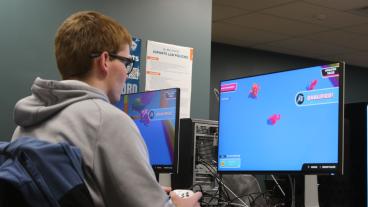A team of Colorado School of Mines students have worked for the past year on a method to reduce the use mercury in small-scale gold mining and the resulting pollution, and recently presented their proposed solution to the Environmental Protection Agency in Washington, D.C.
Team Mad Hatter Mitigation Squad, a group of seven Mines seniors, worked on the project as part of the College of Engineering and Computational Sciences Capstone Design Program. The project was funded by an EPA P3 grant, and the team presented at the TechConnect World Innovation Conference and Expo in May. The team included environmental engineering majors Boshra Alfowzan, Tom Carter and Emiley Lopez; metallurgical and materials engineering majors Laszlo Panyi and Emily Davis; mining engineering major Erika Nieczkoski; and mechanical engineering major Carl Scheevel.
The team was advised by mining PhD student Benjamin Teschner, and their client, Mining Engineering Assistant Professor Nicole Smith. Both Teschner and Smith conducted fieldwork during the summer of 2015 in Suriname with small scale miners, which was the basis for both the grant and student project.
“In the United States, we stopped using mercury in gold mining about 50 years ago,” said Alfowzan. “But around the world, small-scale gold mining is still the number one anthropogenic source of mercury pollution.”
The team focused their project on a gold mining site in Suriname, where small-scale gold mining is socially and culturally important and mercury is widely used in the gold extraction process for efficiency and economic reasons.
“It’s important that the gold have reliable purity so miners can sell to buyers and split profits with their workers,” said Panyi. “Gold produced with mercury has a specific look that buyers and sellers know how to value.”
The team focused on reducing the amount of mercury used, as well as increasing efficiency to reduce pollution. They also invited a miner from Suriname, Jurgen Plein, as well as an anthropologist working in Suriname, Dr. Marieke Heemskerk, to a weeklong workshop on their project.
“The key to this challenge was that the team was able to engage with Jurgen and Marieke and drive their solution from the stakeholder’s perspective,” said Teschner. “They presented a number of ideas to Jurgen and Marieke, and essentially waited to see what Jurgen liked and thought could work. They considered needs of the actual miner in their system and figured out how their design could support them.”
To reduce the amount of mercury used, Team Mad Hatter proposed replacing the stage where the most mercury is being added with a method of gravity separation.
“It works like a giant gold pan,” said Carter. “The gold settles, while lighter materials are swept away. This way, the miners only have to add mercury at the very end of the process, and only on gold-worthy ore.”
The team’s solution met with approval from Plein, who the team described as a “key player in the Suriname mining community.” Beyond using less mercury, their solution also would save miners money, as mercury is very costly and can often only be found on the black market.
Plein also offered to test the team’s solution in Suriname. While the team built a small prototype of their design in Colorado, their full-scale design can be made from locally sourced materials in Suriname.
“It was evident in their final project that their interactions with Jurgen expanded their views of the ways in which engineering can be applied to real world scenarios and can be coproduced with the end users,” said Smith. “I am extremely proud of this team for their dedication to making a difference in the livelihoods of small-scale miners in Suriname.”
Learn more about the Capstone Design Program at Mines by visiting capstone.mines.edu. Photos from this year’s CECS Senior Design Tradeshow can be seen in the slideshow below.
Contact:
Megan Hanson, Communications Manager, College of Applied Science and Engineering | 303-384-2358 | mhanson@mines.edu
Mark Ramirez, Managing Editor, Communications and Marketing | 303-273-3088 | ramirez@mines.edu



